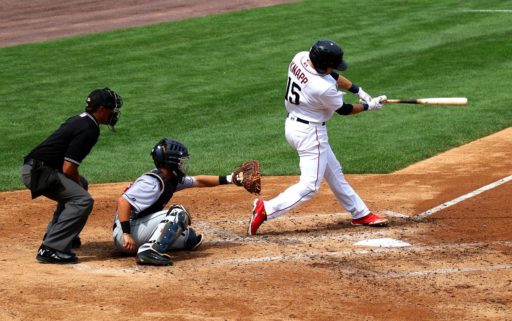My love for major league baseball, specifically the Philadelphia Phillies, is old and deep, but when it comes to taking in a live contest, I’ll take a minor league game any day of the week.
Where I live in northwest Pennsylvania, for twenty-five bucks I can park on the street behind the cozy stadium, get a seat close enough to the action to hear the infield chatter, eat a couple hot dogs, sip a big beer, and watch the Double-A Detroit Tigers affiliate, the Erie Seawolves, scrap against the likes of the Altoona Curve, the Richmond Flying Squirrels, or the Binghamton Rumble Ponies. The kid in center this year might be a gazelle with pop, but he needs more plate discipline if he’s going to make the jump to the bigs one day, and the older half of the squad’s catching platoon calls a great game, but this is likely his final year before hanging up his chest protector and shin guards and trying to land a bench coach job somewhere.
At any rate, I’m enamored with both these stories. Two parts of the same inevitable narrative, really. Fresh-faced hope honed over time into something practical, durable.
This line of thinking seems acceptable and agreeable, perhaps even wise and affirming, on a cool spring evening defined by the breeze coming off the Lake and the small, good-natured crowd’s recreational boos of the home plate ump’s too-large and then too-small strike zone. We, the crowd and I, the circling gulls, the college kids slinging peanuts and fun pops, don’t care so much if the home team wins. We’ll wear their gear and cheer them on, but it’s a low-key, low-stakes loyalty. Conversely, I have to steel myself to watch the Phillies on TV, and if things don’t go well, I’m apt to shoot my dog a dirty look or two across the sofa and begin to pose to her questions of the existential variety. “What’s it all for?” and “Why do I care?” and “Why would any benevolent deity allow for the existence of this bullpen?” This kind of thing. The kind of thing you need a break from every once in a while.
It’s not just baseball. As a reader, teacher, and writer of literary fiction, I know in my bones that the major character, the protagonist, drives any worthwhile plot. The protagonist, in fact, is the plot, and all other elements of the work—setting, point of view, dialogue, diction and syntax—must serve the revelation and development of this personality. Minor characters are enlisted into this service, too, of course. If they don’t function to illuminate the protagonist somehow, they’re not doing their job.
I’d argue, though, that like a minor league baseball team, a minor character has the capacity to transcend their supporting role. Maybe even rebel against it. If the writer’s not careful—maybe the writer should sometimes take care not to be so careful—a minor character might become interesting in and of themselves and, in this way, offer the reader a necessary break now and then from the spotlight-hungry lead.
In Burning Down the House, a collection of essays on the craft of fiction, Charles Baxter writes about how skillful novelists, like Twain in Huckleberry Finn, use well-timed, lyrical, description-heavy scenes of “stillness” to offer the occasional reprieve from tense, busy plots. Readers need a breather from the high-stakes, cause-and-consequence action every once in a while. They need to re-orient and regather themselves to prepare for what lies ahead. A tranquil Mississippi riverscape can do the trick under the right circumstances. I’d suggest that a well-drawn minor character is capable of offering this kind of respite, too.
In The Substance of Things Hoped For, my recently published historical novel set in the mid-nineteenth century, there’s a slew of minor characters orbiting the dual protagonists, John Humphrey Noyes, the self-styled Perfectionist prophet and plural marriage advocate, and Charles Guiteau, the delusional, deranged presidential assassin. Of course, while researching and writing the book, I spent most of my time and effort fostering my relationships with Noyes and Guiteau. I was necessarily obligated and devoted to them first and foremost, and, like all prima donnas, they knew I needed them more than they needed me and acted accordingly. They regularly tried my patience with their unpredictable shenanigans, recalcitrant demeanors, and fickle cycles of loquaciousness and reticence. This kind of thing. The kind of thing you need a break from every once in a while.
So I began to look forward to the brief interludes during which the novel was commandeered by minor characters. When these voices took the wheel, steering the story onto the occasional sideroad or opting now and then for the scenic route, it felt to me like a kind of rejuvenating hiatus. Not that communing with these minor characters was less work, but it was a different kind of work. When Sewell Newhouse, a disenchanted disciple of Noyes, would pipe up with his two cents regarding workplace politics; or Annie Bunn, Guiteau’s ex-wife, would find her voice in reliving a hair-raising marital misadventure; or Lucretia Garfield, the President’s widow, would offer her grief-tinged perspective on loyalty and loss, I was afforded the opportunity to forget temporarily, and then miss, and then with renewed commitment return to the novel’s protagonists. For the writer, these minor characters created space for Noyes’s and Guiteau’s personalities to grow, and they created context for the major characters’ voices to re-strike me as fresh and urgent. I’d like to think they offer something similar to the reader.
In Winesburg, Ohio, Sherwood Anderson’s underrated novel-in-stories, the protagonist and writer-in-training, George Willard, is in large part defined by his supporting cast. The inscrutable Doctor Parcival, the haunted Wing Biddlebaum, George’s own enigmatic parents Tom and Elizabeth, his passionate teacher Kate Swift, the injured and dangerous Wash Williams, and George’s boyhood love, Helen White, just to name a few, work to introduce George more fully to the reader and, most importantly, to himself. At the end of the book, the reader knows George’s apprenticeship has been fulfilled and he is ready to write the stories he needs to write, not because he’s suddenly become a brilliant artist—the narrator admits that no one looking at George “would have thought him particularly sharp”—but because he’s developed a “growing passion for dreams.” As his train pulls out of his boyhood home, George closes his eyes and envisions “not anything very big or dramatic” but rather “a recollection of little things,” an assortment of meaningfully random images and impressions intimately connected to the book’s minor characters, who have come to signify for George, along with Anderson and the reader, the essence of his life.
Tom Noyes is the author of three story collections, including Come by Here: A Novella and Stories, winner of the Autumn House Prize in Fiction and The Independent Press Awards’ Gold Medal in Short Fiction. His most recent book is the historical novel The Substance of Things Hoped For (Slant Books). He directs the BFA in Creative Writing Program at Penn State Erie, The Behrend College and serves as Contributing Editor for the literary journal Lake Effect.





